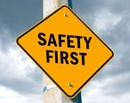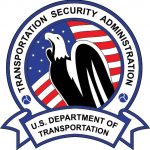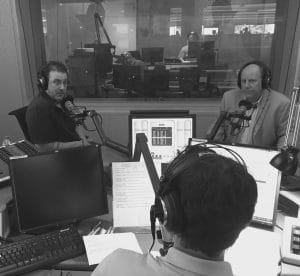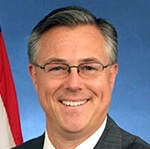Amarillo.com reported that BNSF freight trains collided head-on this morning in the town of Panhandle, Texas, near Amarillo, creating a massive fireball and explosion that prompted a swift evacuation of Panhandle residents. Injuries and missing persons have been reported; at this time, no details have surfaced regarding those missing, or the number or severity of injuries. Read the complete story here.
Photo courtesy of Kayla Burks for Amarillo.com.
Tag: rail safety
Amarillo.com reported that BNSF freight trains collided head-on this morning in the town of Panhandle, Texas, near Amarillo, creating a massive fireball and explosion that prompted a swift evacuation of Panhandle residents. Injuries and missing persons have been reported; at this time, no details have surfaced regarding those missing, or the number or severity of injuries. Read the complete story here.  Photo courtesy of ABC News.
Photo courtesy of ABC News.
Enforcement push is part of broader effort to increase overall rail safety
 WASHINGTON – The Federal Railroad Administration (FRA) today announced that its stepped-up enforcement of railroad safety regulations led to the highest-ever civil penalty collection rate in the agency’s 50-year history.
WASHINGTON – The Federal Railroad Administration (FRA) today announced that its stepped-up enforcement of railroad safety regulations led to the highest-ever civil penalty collection rate in the agency’s 50-year history.
For Fiscal Year (FY) 2015, the agency will collect 75 percent of all civil penalties it issued to railroads for violating federal safety regulations – a six percent increase over FY2014, and the largest percentage rate ever collected by the agency. The total amount of civil penalties in FY2015, $15 million, increased by 12 percent compared to the previous year.
“Safety must be the number one priority for every railroad, and the Department of Transportation will continue to take aggressive action against railroads who fail to follow safety rules,” said U.S Transportation Secretary Anthony Foxx. “A strong safety enforcement program is critical to prevent accidents, save lives and move our country forward.”
FRA’s collection rate is the highest in the agency’s history and significantly higher than previous years.
| Year | Collection Rate |
| FY 2015 | 75% |
| FY 2014 | 69% |
| FY 2013 | 68% |
| FY 2012 | 69% |
| FY 2011 | 68% |
| FY 2010 | 68% |
| FY 2009 | 67% |
Last year, more than 6,485 railroad company violations resulted in civil penalties. The largest portion of those violations, 29 percent, was for motive power and equipment violations, followed by 26 percent for track violations.
| FRA Safety Discipline | Violations Resulting in a Civil Penalty | Percentage |
| Hazmat | 1,327 | 20% |
| MP&E | 1,869 | 29% |
| OP | 1,184 | 18% |
| Signal & Train Control | 416 | 7% |
| Track | 1,689 | 26% |
| TOTAL | 6,485 |
“Setting a record for collections is an important milestone, but it is just one element of FRA’s broader effort to achieve a safer rail system,” said FRA Administrator Sarah E. Feinberg. “As we continue to aggressively enforce safety regulations, FRA will also continue to implement new, innovative solutions to increase safety.”
The stepped-up enforcement of safety regulations is part of the Federal Railroad Administration’s larger, comprehensive effort to increase safety of the nation’s rail system. Administrator Feinberg has also prioritized railroad crossing safety, improving the safety of hazmat and crude transport, increasing transparency and working more closely with the National Transportation Safety Board (NTSB).
To read the full report, visit: https://www.fra.dot.gov/eLib/details/L17311#p1_z5_gD
Both inspectors for a state rail safety program — aimed to prevent such fiery derailments involving crude oil as happened this year near Weimdal, N.D. — have been hired and are training with federal inspectors.
In July, an agreement was approved by the Public Service Commission with the Federal Railroad Administration to begin a pilot rail safety program in the state. The program is to supplement the work of the several FRA inspectors assigned to North Dakota and several other states in the region.
Read more from The Bismarck Tribune.

The House Homeland Security Committee’s subcommittees on intelligence and on transportation security and counterterrorism will meet Thursday, September 17, 2015, to discuss protections for U.S. train passengers after three Americans stopped a gunman and saved hundreds of passengers on a train from Amsterdam to Paris.
Read more from The Hill.
Senators urge TSA to immediately complete measures required in 2007 legislation.
“Tens of millions of riders use our country’s public transportation and passenger rail systems every day, and these networks serve as the backbone of economic activity throughout the country…While aviation security is a vital focus of the TSA, your agency also has a critical role to play in protecting rail and transit passengers.”

In 2007, Congress passed the Implementing Recommendations of the 9/11 Commission, measures the 9/11 Commission urged Congress to adopt to ensure greater security on all of America’s transit systems. The legislation required TSA to create a regulatory framework that addresses the threats facing our passenger rail and transit agencies by having security plans in place, ensuring proper security training for employees, and requiring thorough vetting for those working on the systems.
“Tens of millions of riders use our country’s public transportation and passenger rail systems every day, and these networks serve as the backbone of economic activity throughout the country,” the senators wrote. “Our rail and transit networks carry significantly more people per day than our airlines do. Penn Station in New York City, for example, handles half a million passengers each day – making it busier than all three New York City regional airports combined, and the busiest transportation hub in our country. While aviation security is a vital focus of the TSA, your agency also has a critical role to play in protecting rail and transit passengers.”
“Action on many Congressional mandates has languished for far too long…The legislation was enacted in August 2007 and these items were all due within one year of that date. As of August 2015 – over seven years since the last deadline – we still do not have final action on these requirements. These are urgent priorities and completion of these mandates will further prepare us for emerging threats on the horizon.”
“Last week, three Americans traveling in Europe heroically subdued an armed terrorist attempting to attack and kill passengers on a Paris-bound train. The swift action of these men averted a catastrophe that could have claimed many lives. This close call requires that we consider the vulnerabilities this incident – and several other high-profile attacks on rail and transit elsewhere globally – expose for our rail and transit passengers. This is why we ask for action on long overdue requirements placed on the Transportation Security Administration (TSA) by Congress.”

Titled “Back on Track: Bringing Rail Safety into the 21st Century,” the report examines the nation’s aging rail infrastructure and highlights current deficiencies in the rail system.
Using government data, the report’s authors found that about 73 percent of all derailments between 2011 and 2014 were the result of faulty track integrity and human error. Such incidents are likely to continue to occur unless those issues are addressed, according to the report.
Read more from Progressive Railroading.
MPR news interviewed Vice General Chairperson of Union Pacific GO 225 Randy Raskin and Minnesota State Legislative Director Phil Qualy, both of Local 650 (Minneapolis), during an ongoing series of conversations about rail safety in Minnesota.
MPR News’ Tom Weber interviewed Raskin and Qualy for their expertise on trains from the inside out.
They talked about the jobs of conductors and engineers and what role they play in ensuring the safety of our railways.
Listen to the interview from MPR News.

Raskin and Qualy

Federal Railroad Administration chief Joseph Szabo testified April 10 before members of the Surface Transportation Board regarding the negative impact service degradation on the nation’s railroad network could have on rail safety and Amtrak on-time performance.
His prepared oral testimony follows:
Chairman Elliott and Vice Chairman Begeman, on behalf of Transportation Secretary Anthony Foxx, thank you for the opportunity to testify today about the negative impact service degradation in our Nation’s rail network can have both on rail safety and on Amtrak’s on-time performance.
Let me first talk about FRA’s top priority – rail safety.
Over the past decade, our-data based oversight and enforcement has helped the industry achieve a 47 percent decrease in both train accidents and derailments, and a 35 percent decrease in highway-rail grade crossing accidents.
By most measures, Fiscal Year 2013 was the safest year on record. But we owe it to the public to always do better.
And that’s why the railroad’s weekly metrics showing railroad performance declines among Class I carriers are a big concern to us.
As railroad performance declines, rail velocities diminish, cars on line increase, terminal dwell time increases – and above all, our experience tells us, safety can suffer, too.
We learned this with the significant service degradation Union Pacific/Southern Pacific faced about 15 years ago – when we testified before the Board – as an example of how quickly operating conditions can change and affect safety.
Experience tells us there can be a safety breakdown, for example, when it comes to the ability of supervisors to perform their jobs, as a consequence of additional work pressures.
Ineffective crew utilization can lead to employee fatigue. And in order to ensure adequate rest, crews need absolute predictability as to when they go to work.
And, as a railroad rushes to gain the upper hand on service issues, it becomes necessary to hire new employees. Without adequate training that instills the proper safety culture, the number of accidents is likely to rise.
As large of a role as the Nation’s freight railroads have in serving our Nation’s businesses and economy, no concern must ever come before safety.
That’s why we have been monitoring this service situation closely and meeting with railroad CEOs to gain assurances that the carriers are operating in the safest manner.
In BNSF’s letter to the Board in response to the Western Coal Traffic League’s request for a proceeding concerning rail service problems, the railroad announced that it will be hiring 5,000 employees in 2014 to relieve these service pressures.
While laudable, it is imperative that the railroad undertake the proper training to ensure that the railroad operates in the safest manner.
We also have noticed a marked increase in delays to Amtrak trains and an associated degradation in on-time performance.
DOT and FRA provide financial assistance to Amtrak to partially fund its operations and capital investments, and work to support Amtrak’s efforts to enhance its passenger rail services. For these reasons, Amtrak’s financial performance is of great interest to us.
And in keeping with our nationwide mandate to improve the safety of passenger and freight railroads, we focus closely on the safety of Amtrak’s facilities, equipment, and transportation operations.
It should be noted that Amtrak has set ridership records in 10 out of the last 11 years – and last year was relied upon by more than 32 million travelers. So, service issues that ultimately delay intercity passenger trains have many negative implications for travelers, Amtrak, and the transportation network as a whole.
Late trains may cause travelers to miss connections or abandon their travel plans entirely. Reduced ridership and additional operating delays cause Amtrak immediate and, potentially, long-term financial harm.
A slower, less efficient passenger rail network reduces travel options for some and may put more strain on other modes of transportation, as well.
DOT and FRA closely monitor the on-time performance of Amtrak services, because even just a few months of poor performance have the potential to cascade into long term problems.
Over the past twelve months, we have witnessed a steady decline in timeliness of Amtrak trains, particularly those that operate over the freight rail network.
Only about 63 percent of Amtrak’s Long Distance trains reached their endpoint on time between March 2013 and February 2014 – 12 percent worse than the previous 12 months.
From December 2013 to February 2014, half of all Long Distance trains were late to their final destination.
On-time arrivals to intermediate stations on Long Distance routes were even less frequent, at 48 percent over the last 12 months and just under 40 percent this past December through February.
Shorter, State Corridor trains did not fare much better, with nearly a quarter, 22 percent, of all such trains arriving late over the past 12 months.
Amtrak’s on time performance has been a long-term interest of this Department and of Congress – and Amtrak tracks and reports all train delays to the FRA.
For February 2014, the month for which data was most recently reported to FRA, delays attributable to the host freight railroad were the highest in over 5 years. The largest category of Amtrak delays in recent months has been host freight train interference.
Such a designation is based on the Amtrak conductor’s immediate observable cause.
The extreme delays to Amtrak and other users of the network are a symptom of a fragile network that is strained and struggling to react.
Thank you for providing DOT the opportunity to comment in the proceeding. I would be happy to answer questions.
 Railroad accidents pose significant safety risks to railroads, their employees, passengers, and the public.
Railroad accidents pose significant safety risks to railroads, their employees, passengers, and the public.
FRA oversees safety of the nation’s railroads. In light of three high profile accidents in 2012 involving fatalities or hazardous materials, GAO was asked to review FRA’s oversight processes and the challenges to railroad safety.
This report examines (1) the overall framework that FRA, the states, and the railroads use to ensure rail safety; (2) the extent to which FRA and the railroads assess safety risks and allocate resources to address those risks; and (3) what challenges, if any, exist to FRA’s current safety framework, and what ongoing and emerging issues FRA faces.
GAO analyzed FRA accident and incident data, reviewed the analytical models FRA uses to incorporate risk into its inspection program, and interviewed FRA headquarters and field safety staff, officials from the seven largest freight railroads and 11 smaller railroads, industry associations and seven rail labor organizations.
Click here to view the report.